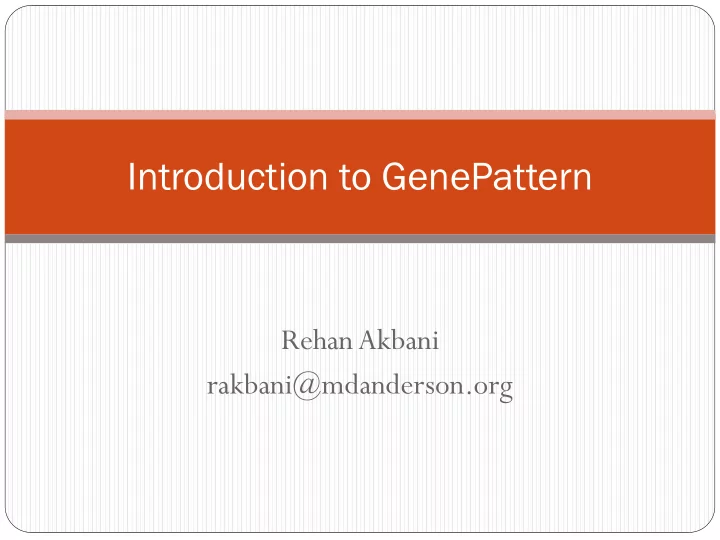

Introduction to GenePattern Rehan Akbani rakbani@mdanderson.org
Overview What is GenePattern and why do I care? 1. How do I convert my script into a GenePattern module? 2. How do I create customized GenePattern pipelines? 3. How do I share my software/data with others? 4. How do I make my research reproducible using GenePattern? 5.
What is GenePattern and why do I care? GenePattern (GP) is server software created by the Broad Institute What does it do? Browser based client side 1. Allows interoperability between software tools ( modules ) 2. Modules can be heterogeneous; using different languages and libraries 3. Easily converts a module into a web service 4. Allows the creation of workflows ( pipelines ) 5. Modules/pipelines can be called directly from Java, Matlab or R 6. Modules/pipelines can easily be shared 7. Allows reproducible research 8.
What is GenePattern and why do I care? TCGA will be using a GenePattern/Firehose pipeline to perform their monthly analysis runs (branded under NIH/NCI) GP will allow MDACC GDAC Analysis group to easily share tools internally GP server at Broad (free registration required): http://genepattern.broadinstitute.org/ MDACC local GP server behind firewall: http://mdadqsgdac1.mdanderson.edu:8080/gp/
How do I convert my script into a GP module? Analysis Modules 1. Non-interactive, command line based Runs on the GP server Visualization Module 2. Can be interactive Runs on client’s machine using Java applets
How do I convert my script into a GP module? Write a command line tool using any language Read/write input/output files from the current working directory Write messages to standard error and standard output Read module data files from <libdir> Read and write standard GenePattern file formats (e.g. gct, res, odf) Use command line parameter flags, instead of location Avoid absolute pathnames Ref: http://www.broadinstitute.org/cancer/software/genepattern/tutorial/ gp_programmer.html#_Writing_Modules_for_GenePattern
How do I convert my script into a GP module? Install your module into GP (if you have access rights) e.g. invocation: <perl> <libdir> myProg.pl -F <input.filename> -o <output.file> Click “Modules & Pipelines” - >”New Module” Easily possible in MDACC GP , but not Broad due to access rights Decide if you want it to be public or private Ref: http://www.broadinstitute.org/cancer/software/genepattern/tutorial/ gp_web_client.html#creating_tasks
How do I create customized GP pipelines? Input File(s) Module 1 Module 2 Output File(s) … GP Pipeline See demo
How do I share my software/data with others? See demo
How do I make my research reproducible using GP? Jill Mesirov , “Accessible Reproducible Research,” Science, 22 January 2010: Vol. 327. no. 5964, pp. 415 – 416 Reproducible Research System (RRS) Reproducible Research Reproducible Research Publisher (RRP) Enviroment (RRE) e.g. MS Word GP plugin, e.g. GenePattern, R SWEAVE
Recommend
More recommend